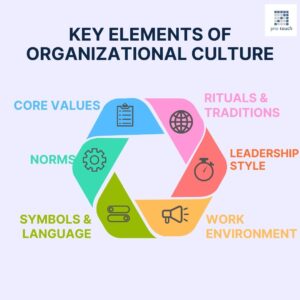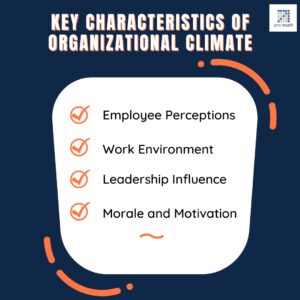Organizational culture refers to the shared values, beliefs, attitudes, and behaviors that shape how people within an organization interact and work together. It’s the social and psychological environment of a company — the “personality” of the organization.
Key Elements of Organizational Culture:
- Core Values: Fundamental beliefs that guide behavior (e.g., innovation, integrity, teamwork).
- Norms: Unwritten rules about how to behave (e.g., dress code, meeting etiquette).
- Symbols & Language: Logos, slogans, internal jargon, or stories that express the company’s identity.
- Rituals & Traditions: Regular practices like team lunches, awards, or annual events.
- Leadership Style: How leaders behave, communicate, and make decisions.
- Work Environment: Whether it’s formal or casual, hierarchical or flat, collaborative or independent.

Types of Organizational Culture (based on the Competing Values Framework):
- Clan Culture: Friendly, people-focused, like a family (e.g., startups, nonprofits).
- Adhocracy Culture: Innovative, risk-taking, and dynamic (e.g., tech companies).
- Market Culture: Results-driven, competitive, and goal-oriented (e.g., sales organizations).
- Hierarchy Culture: Structured, controlled, and process-focused (e.g., government agencies).
Why Organizational Culture Matters:
- Influences employee satisfaction, engagement, and retention.
- Affects how decisions are made and how change is managed.
- Impacts organizational performance and customer experience.
In short, organizational culture is what it’s like to work at a place beyond just the job description — it’s how things get done and how people feel doing them.
Organizational climate refers to the overall atmosphere or “feel” of the workplace as experienced by employees. It’s shaped by perceptions of policies, practices, leadership, and day-to-day interactions — essentially, how employees feel about working in the organization.
While organizational culture is about deeply rooted values and beliefs, organizational climate is about employees’ current perceptions and emotional responses. Know more in detail with these courses in change management, organizational development certification.
Key Characteristics of Organizational Climate:

- Employee Perceptions: How employees view management, teamwork, communication, recognition, etc.
- Work Environment: The emotional tone — is it stressful, supportive, relaxed, high-pressure?
- Leadership Influence: Leaders’ behavior directly affects the climate (e.g., openness, fairness).
- Morale and Motivation: Climate affects how motivated and satisfied employees feel.
Dimensions Often Used to Measure Climate:
- Support: Do employees feel valued and heard?
- Clarity: Are goals, roles, and expectations clear?
- Autonomy: Do employees have freedom in their work?
- Recognition: Are achievements acknowledged?
- Innovation: Is new thinking encouraged?
Difference Between Culture and Climate:
| Aspect | Organizational Culture | Organizational Climate |
| Nature | Deep-rooted values and norms | Employees’ current perceptions |
| Stable or changing? | Long-term and stable | Short-term and changeable |
| Focus | “Why things happen this way” | “How it feels to work here now” |
| Example | A culture of innovation | A climate of stress due to tight deadlines |
Why Organizational Climate Matters:
- Directly impacts productivity, engagement, and retention.
- Reflects the effectiveness of leadership and management.
- Helps identify areas for improvement in employee experience.
In essence, organizational climate is the mood of the workplace — what it feels like to come to work every day.
Here’s a clear comparison of organizational culture vs. organizational climate, highlighting their key differences:
| Aspect | Organizational Culture | Organizational Climate |
| Definition | The shared values, beliefs, and norms that shape behavior in an organization. | The current mood, perceptions, and attitudes of employees about their work environment. |
| Nature | Deep-rooted and enduring. | Surface-level and changeable. |
| Focus | “Why things are done the way they are.” | “How it feels to work here right now.” |
| Timeframe | Long-term; develops over years. | Short-term; can shift quickly. |
| Components | Core values, traditions, symbols, leadership style. | Morale, trust, communication, stress levels. |
| Influenced By | Founders, leadership, company history, strategic goals. | Leadership behavior, policies, recent events or changes. |
| Measurement | Harder to measure; assessed through cultural audits or ethnographic studies. | Easier to measure; typically assessed through employee surveys or feedback. |
| Examples | A company has a culture of innovation and collaboration. | Employees feel stressed and unsupported this quarter due to tight deadlines. |
| Impact | Guides consistent behavior and decision-making. | Affects day-to-day performance, engagement, and morale. |
Conclusion:
Culture is the foundation — what the organization is.
Climate is the weather — how it feels to work there now.
Both are interconnected: a healthy culture often leads to a positive climate, and shifts in climate can signal needed cultural changes. Courses in change management, organizational development certification can help in developing a deep understanding.
Organizational culture and climate are closely related but distinctly different concepts. Culture represents the deep-rooted values and guiding principles that shape how an organization operates, while climate reflects the current atmosphere and employee perceptions within that environment. Understanding both is essential for leaders and HR professionals to build a thriving workplace. A strong, positive culture lays the foundation, while a healthy climate ensures employees remain engaged, motivated, and productive in the short term. Together, they influence overall organizational success and employee well-being.





Leave a Reply